Of villages and beauty business The Lupin Foundation in Bharatpur helps farmers, artisans and also trains young women to meet the demand for beauty care in Indian villages.
The beautiful young girl operating her computer startles me totally when she answers my query with an expressionless: “Mere husband khatam ho chuke. He committed suicide by hanging himself.”
Rekha Sharma is only 24, got married five years ago and lost her husband 18 months after marriage. “He wasn’t doing any work. He didn’t like it when we asked him to find a job and killed himself.”
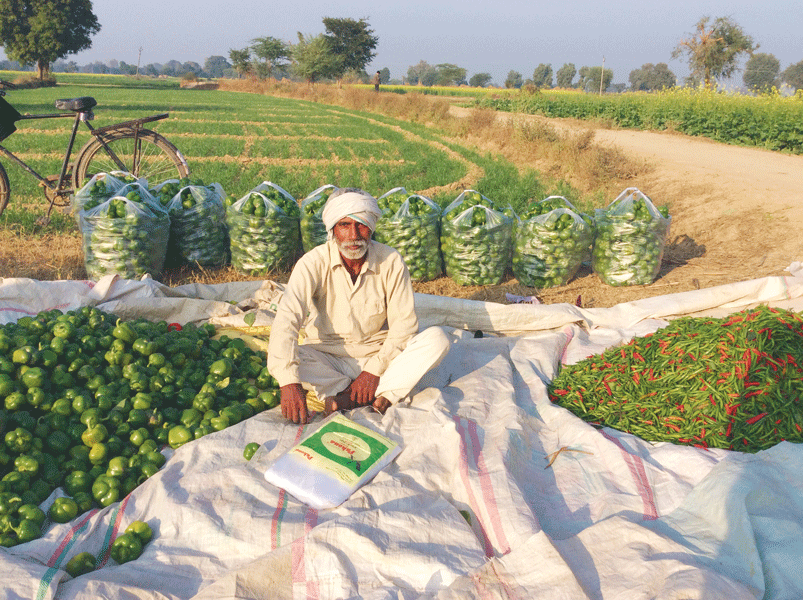
I am at the computer training centre run by the Lupin Human Welfare & Research Foundation (LHWRF) at Kumher town, about 40 km from Bharatpur in Rajasthan. Even before it became mandatory for the bigger profit-making corporates to use two per cent of their profits to help the needy, the pharma major Lupin has been working earnestly in small Indian towns and villages from 1988, changing lives and livelihoods. Its annual budget is a whopping Rs 32 crore, more than mandated by government.
Returning to Rekha, part of a 20-girls batch, after her husband’s suicide, she completed Class 12, and “decided to stand on my own feet.” The training is free and the girls bright and eager to learn. Though, on the Net, their first searches are related to films, songs and Bollywood celebrities.
I had no clue that this beauty business has become such a big hit in villages.
Swati Samvatsar
LHWRF Chief Programmes Manager, Dr Swati Samvatsar is amazed that most of Bharatpur’s young girls want to learn all about the beauty business.
All about beauty
A few months ago when a Class 11 girl requested training in beauty care, the flood gates opened. “I had no clue that this beauty thing has become such a big hit in even small villages of Rajasthan. I doubted we’d get 50 girls; I had to close the registration at 560, and hire three classrooms to train them in batches!” With no dearth of beauty parlours in this region, Swati could get enough trainers to teach skin care, facials, waxing, threading, hair-cutting/styling in the 40-day training course.
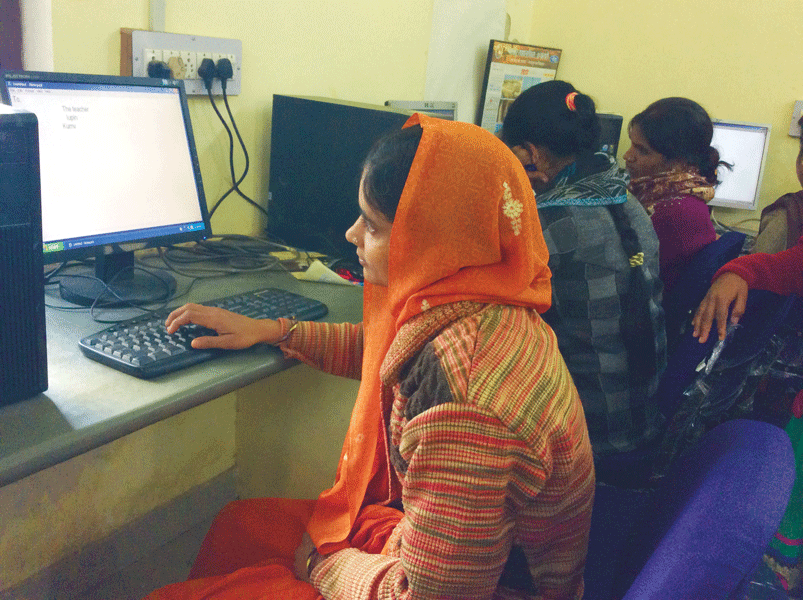
With Karva Chauth becoming “a national festival” in Rajasthan’s towns and villages, and marriages a big business, the trained girls are suitably engaged. But she got “stumped again, when the girls wanted to learn four kinds of Mehndi … I didn’t know about the Bombay, Arabian styles. Next when they asked about nail art, I realised how outdated I am!”
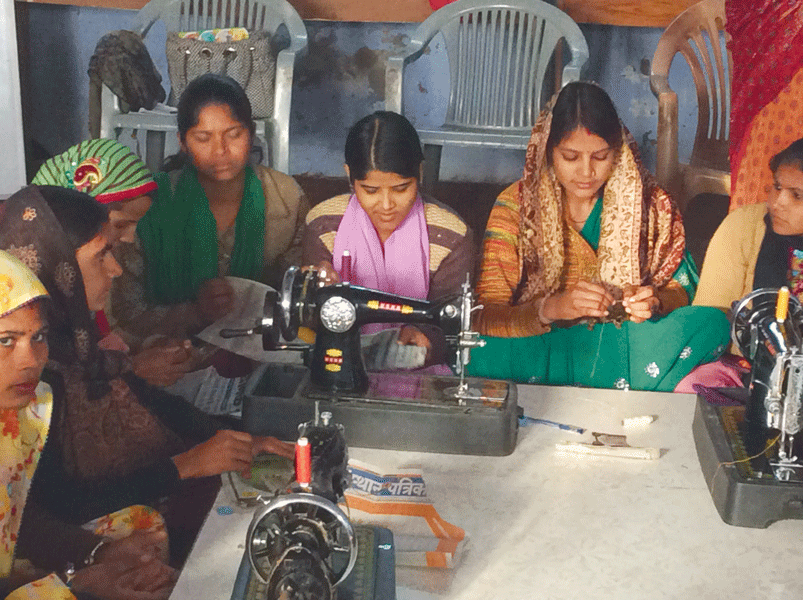
She adds that mehndi and bridal make-up can get these girls mega bucks — of a few thousand rupees —
during a wedding. The courses were completed in June and five girls have already started their parlours, employing four other students! They now earn Rs 3,000, but as they get experience, the bigger parlours will give them better income.
IT partners sewing!
We also visit the tailoring class in a nearby room, and it is good to note that many young women here are attending computer classes too. Mamata Devi (22), is wearing an expensive saree and is well groomed. Her husband is becoming a graduate. “After a computer course, I hope to find a job; the tailoring skills will be useful at home.”
Swathi regales me describing the party — complete with a DJ and dancing — that the earlier batch of girls had held. “I was invited too, and had a great time,” she smiles.
With computer skills I will find a job; tailoring I’ll do at home.
Mamata Devi
With demand coming in for security guards — a placement agency wants 1,000 — it has now started a 90-day training course, complete with use of light weapons, for batches of 30. Increasingly companies, banks and even toll-booths require security personnel. Training is expensive — Rs 60,000 or more with private agencies — as it requires hiring firearms. But the Foundation offers it free to the disadvantaged, spending about Rs 13,000 for each student, as certified weapon trainers have to be hired.
28 types of training
The LHWRF offers 28 different types of training, and this includes courses for plumbers, electricians, gem cutters, dairy and livestock rearing, tulasi mala making, food processing and mobile phone repairs. “The last is in great demand in villages, and simple glitches are fixed for Rs 20 to 50.” The trainers are ITI alumni. The Foundation also has linkages with SIDBI, some banks and the National Skill Development Agency. Most courses last for 30 days and the beneficiaries are mostly from Bharatpur district.
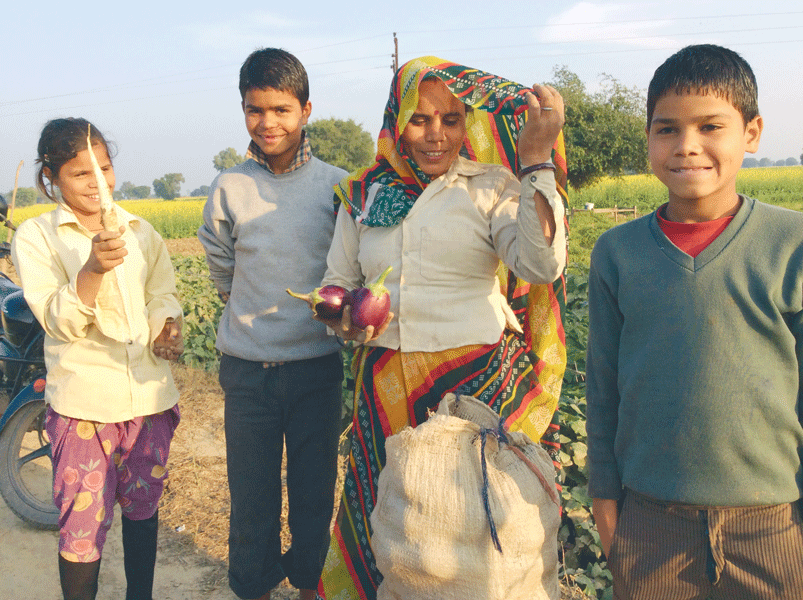
Swathi, a PhD in Botany and tribal management, has been with the Foundation for 30 months, has reached 85,000 homes and wants to reach at least a million. She is sure that soon they will have a course for women security guards as there is demand for that too. They’ve already trained 32 female bus conductors.
Changing farmers’ lives
As always, it is a delight to see how intervention and handholding works wonders for Indian farmers. At Abhaya village near Bharatpur, Ranvir Singh, who owns 8 bigha land and earns a profit of Rs 25,000 from a bigha if he grows vegetables such as onions, tomatoes, peas, is now planning to shift more towards vegetables from wheat and bajra.
Gaadi toh beti ki shaadi mei deney hi padti hei.
Ranvir Singh
Like others, he too has been trained and encouraged by Lupin to keep buffaloes; he has four, each giving 10–14 litres of milk every day, most of which he sells at Rs 40 a litre. Of his two sons, one works with the Punjab National Bank; the second son is in high school, and will handle the dairy operations after his education!
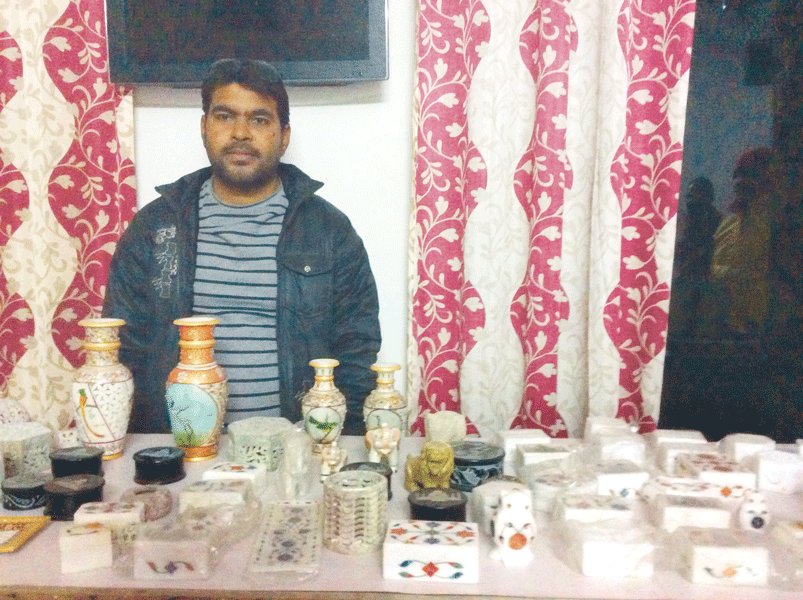
One of his two daughters is married. The good news is that he did not have to borrow even a part of the Rs 10 lakh he spent on the wedding; the bad news is that he had to buy a car worth Rs 6.5 lakh for the bridegroom. “Gaadi toh deney hi padti hei (Of course one has to give a car),” he says.
From Lupin, farmers like him get free seeds, timely advice, training on the best practices and how to keep their livestock healthy. And innovation; Swathi explains how he grows maize in only water, without soil.
Babita, a female farmer, has just harvested a bountiful crop of brinjals, radish and green chillies. Initially the brinjals fetched her Rs 12–13, but with more supply hitting the market, the prices have now crashed to Rs 5 a kg. She has three boys and a girl, and is sending all of them to school.
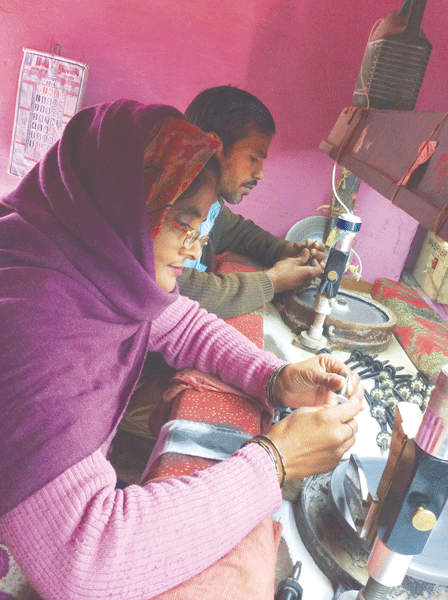
Babita chases Lupin’s “Madam” for dawai (pesticide), and gets an evasive reply. Later Swathi explains how everybody wants pesticides “but we want them to grow organic food to preserve the eco-system.”
Barely a few feet away, another farmer, Mohan, is puffing away on his sheesha … he is sitting in front of a huge expanse of piled capsicums and green chillies. A man of few words, he is happy cultivating vegetables. At good times a kg of capsicum fetches Rs 30.
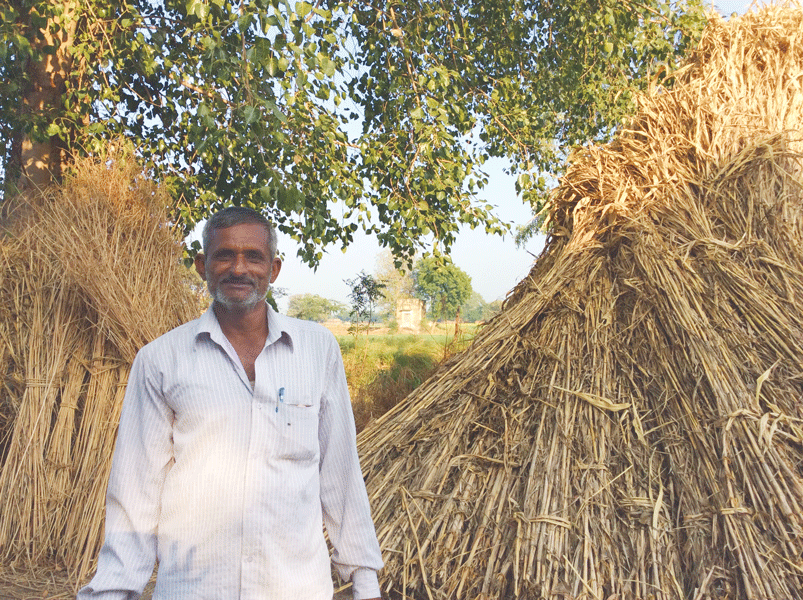
It is interesting to see the entire region filled with enchanting yellow mustard fields. This is because this region has saline water and mustard is a salt-resistant crop.
Har kadam saath-saath
From daily labourer and stone-cutter, Chander Dev’s journey to owning a shop near Bharatpur and a factory in Agra, employing over 50 people, and having “unlimited work,” is a notable one. Dev’s impressive shop in Chak Vehnera, 7 km from Bharatpur on NH11, is filled with exquisite, colourful marble carvings, candlesticks, jewellery boxes, pen holders, lamp shades, magnets, coasters and washroom accessories. It is a shopper’s delight.
Ten years ago, while working in Kishangarh, 350 km from Bharatpur, he came in contact with the Lupin Foundation, which trained him and organised finance to buy a machine costing Rs 35,000. They also helped remove middlemen and now his products go directly to exporters in Muradabad and Delhi and are exported to the US, Europe, Russia and Dubai. Dev’s monthly sales exceed Rs 5 lakh, with a profit margin of 10-12 per cent.
“Har kadam par, har museebat me Lupinwalo ne saath diya. (At every step, every difficulty, Lupin supported me),” he says. Entrepreneurs like him are also sent to national exhibitions and trade shows.
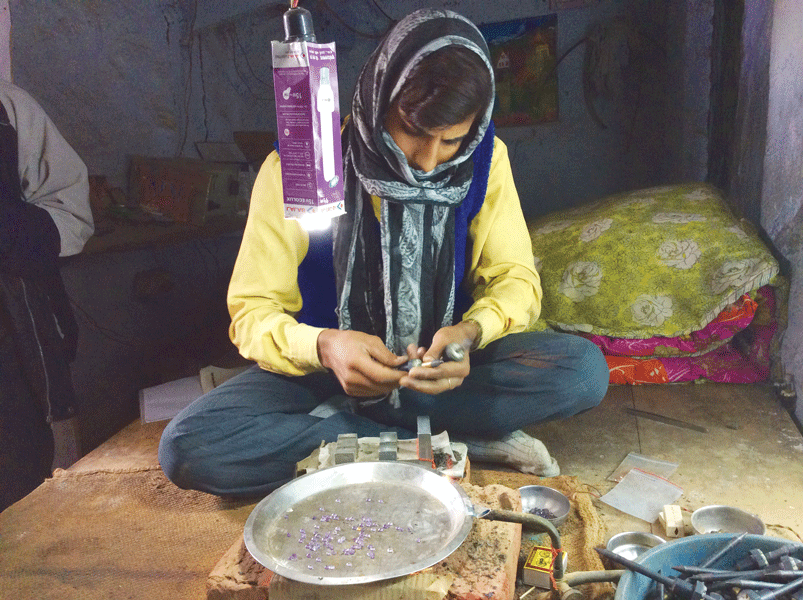
Milin Pandit, Chief Projects Coordinator says, “We pay for their stalls and have developed their website. We are trying to get such entrepreneurs export license but too many clearances and paper work come in the way.”
Dev has an order for 20,000 coaster sets, each costing Rs 800, for a Dubai client, but only through an agent. “If they can get me a direct export linkage, my profits will go up substantially.” About 110 artisans like him have been trained in this, and the next village, in marble cutting and statue making.
But lack of power in this village, as well as other towns nearby, is hampering the work of these artisans. At Dev’s unit that I visit after sunset, two workers are chipping away under a light powered by a generator. Here and in the gem-cutting units I visit the next day, artisans say they get electricity for barely four hours a day, and diesel cost cuts into their savings.
Hemant Sharma, LHRWF’s Senior Programmes Coordinator, says the Foundation has supplied 1,000 solar lanterns to these artisans at Rs 205, half the cost price. “There is demand for 500 more.”
He adds that at Roopnagar Sikri, 65 km from Bharatpur, the Foundation has trained over 100 artisans; of these 60 now own their own units. “We’ve also helped them get Rajasthan Government artisan cards. Now the State Government plans an artisans’ village across 26 bigha of land.”
Over 200 artists have been trained in new designs, colouring etc, and given financial linkage. Many have started their own shops and generated employment, thus checking migration to cities.
The same is true for gem cutting. At Nagla Dhakad, 50 km from Bharatpur, at Maheshchand Dhakad’s unit, eight workers are transforming dull looking, unpolished semi precious stones such as Brazilian Amethyst and citrine into glittering gems. He had 20 years experience but his venture really took off after special training and a loan of Rs 50,000 through SIDBI.
He makes a profit of Rs 35,000 a month from this unit, but can make more if a few glitches are sorted out. Assured power supply, direct link to exporters and more loans — workers demand advance — and there is shortage of skilled manpower as there are plenty of orders. Sharma says Lupin is trying to organise finance to these artisans to buy solar panels costing Rs 2.5 lakh, for which there is government subsidy.
There are 45 units in the two adjoining villages, each employing 8 workers. The gems go to Johari Bazaar in Jaipur for silver, gold and even diamond jewellery. Some are exported.
Kamala and Lalchand Dhakad, a couple, employ 8 workers in their unit and along with them cut and polish Amethyst and white topaz, which glitter like diamonds. “These go to the London market,” beams Lalchand.
Again most of the entrepreneurs have milch animals and make good money selling the milk at Rs 30–35 a litre. Rajesh Mohan started his own unit after being trained by experts from Jaipur, and earns upto Rs 50,000 a month. His son, after completing his engineering course in Kota, will join him and “expand our business.”
